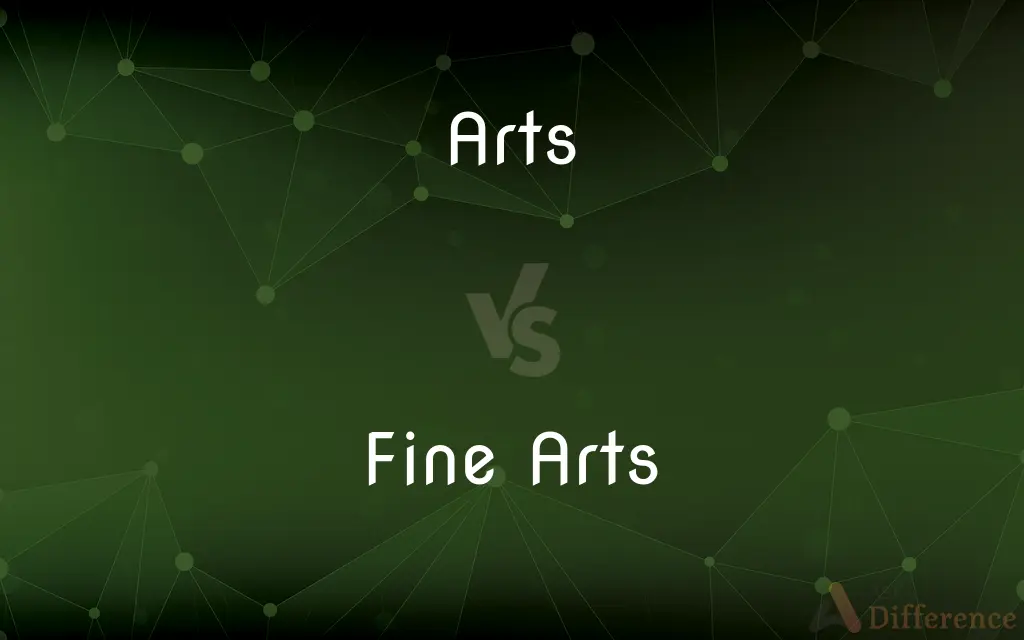Arts vs. Fine Arts — What's the Difference?
Edited by Tayyaba Rehman — By Fiza Rafique — Published on December 26, 2023
Arts generally encompasses all creative expressions, while Fine Arts typically refers to visual arts and performance arts that prioritize aesthetic and conceptual qualities.

Difference Between Arts and Fine Arts
Table of Contents
ADVERTISEMENT
Key Differences
Arts encompass a broad array of creative expressions, including both visual and performing forms. In contrast, Fine Arts elevate the visual and performing arts into a sphere that emphasizes aesthetic and conceptual sophistication.
Arts can embody an extensive variety of disciplines, such as music, theatre, dance, and visual creations. Alternatively, Fine Arts frequently incorporates disciplines such as painting, sculpture, and classical music, which are often perceived as possessing elevated aesthetic and cultural value.
Arts offer a platform for individuals to express their creative ideas through various mediums and practices. On the other side, Fine Arts typically engage with a narrower scope, predominantly focusing on visual and performance media that are often analyzed and critiqued on a deeper, more scrutinized level.
Arts are often recognized for their power to communicate stories, emotions, and ideas, transcending barriers and forming connections. Conversely, Fine Arts, while also communicative and emotive, commonly intertwine a pronounced level of technical skill and innovative conceptuality, frequently establishing them in a more academically rigorized context.
Arts bring together an eclectic and inclusive amalgamation of creative manifestations, contributing to cultural and social discourse. Simultaneously, Fine Arts, often encapsulated within a specialized and somewhat elitist framework, advance notions of aesthetic superiority and conceptual depth, aiming for transcendence in artistic expression.
ADVERTISEMENT
Comparison Chart
Scope
Broad, includes various forms of expressions
Narrower, focusing on aesthetic expressions
Inclusion
Encompasses both performing and visual arts
Primarily involves visual and performing arts
Accessibility
Generally more accessible and inclusive
May be perceived as more elite or exclusive
Purpose
Varies: entertainment, expression, etc.
Heavily leans on aesthetic and conceptual
Representation
Can be representational or abstract
Often viewed through a scholarly lens
Compare with Definitions
Arts
Arts encompass various creative disciplines.
He enjoys exploring the arts, such as dance and sculpture.
Fine Arts
Fine Arts often involve a higher degree of scholarly scrutiny.
Fine Arts exhibitions usually encourage deep critical analysis.
Arts
Arts often communicate emotions, ideas, or narratives.
He arts offer a universal language that speaks to all.
Fine Arts
Fine Arts are typically visual arts like painting and sculpture.
She found solace in creating sculptures, diving deeply into Fine Arts.
Arts
Arts are both visual and performing manifestations of creativity.
He expressed herself through various forms of the arts.
Fine Arts
Fine Arts are dedicated to aesthetic and conceptual expressions.
He devoted himself to the study of Fine Arts to understand aesthetic principles.
Arts
Arts can be traditional or contemporary in style and form.
Hrough the arts, she found a unique way to convey her thoughts.
Fine Arts
Fine Arts often elevate traditional mediums to high art.
His mastery in painting is celebrated in the Fine Arts community.
Arts
Arts are expressions through mediums like paint, sound, or movement.
He arts play a crucial role in cultural development.
Fine Arts
Fine Arts prioritize aesthetic value and artistic skill.
Classical music is often classified under Fine Arts due to its complexity.
Arts
The conscious use of the imagination in the production of objects intended to be contemplated or appreciated as beautiful, as in the arrangement of forms, sounds, or words.
Arts
Such activity in the visual or plastic arts
Takes classes in art at the college.
Arts
Products of this activity; imaginative works considered as a group
Art on display in the lobby.
Arts
A field or category of art, such as music, ballet, or literature.
Arts
A nonscientific branch of learning; one of the liberal arts.
Arts
A skill that is attained by study, practice, or observation
The art of negotiation.
Arts
Arts Artful devices, stratagems, and tricks.
Arts
Artful contrivance; cunning.
Arts
(Printing) Illustrative material, especially in contrast to text.
Arts
A second person singular present indicative of be.
Arts
Plural of art.
Arts
The humanities.
Arts
The study of languages and literature.
Arts
The study of literature, philosophy, and the arts.
Arts
The liberal arts.
Arts
Studies intended to provide general knowledge and intellectual skills (rather than occupational or professional skills);
The college of arts and sciences
Common Curiosities
Can "Arts" include practical or applied arts?
Yes, "Arts" can encompass both fine arts and applied arts, which include fields like graphic design, fashion design, and architecture, where aesthetics and functionality coexist.
Is photography considered a Fine Art?
Photography can be considered a fine art when it's approached with an aesthetic or conceptual focus rather than just a documentary or practical one.
Which disciplines are traditionally included in "Fine Arts"?
Traditionally, fine arts encompass visual arts (like painting and sculpture), music, theatre, dance, and poetry.
How do "Fine Arts" differ from "Arts"?
Fine Arts are a subset of the arts, typically referring to disciplines that focus on the creation of beautiful objects, such as painting, sculpture, music, and dance, primarily for aesthetic and intellectual purposes rather than practical or functional ones.
Can one study "Fine Arts"?
Absolutely! There are numerous institutions worldwide that offer degrees and courses in various disciplines of fine arts.
How are "Fine Arts" typically showcased?
Fine Arts are commonly showcased in galleries, museums, theaters, concert halls, and various other cultural institutions and events.
What are "Arts"?
Arts refer to a diverse range of human activities that involve the creation of visual, auditory, or performance artifacts that express the creator's imagination, conceptual ideas, or technical skill.
Do "Fine Arts" have a specific purpose?
While fine arts are primarily created for aesthetic and intellectual contemplation, they often provoke thought, evoke emotions, challenge conventions, and reflect societal values or critiques.
Are "Arts" always tangible creations?
No, "Arts" can be both tangible, like a sculpture or painting, and intangible, like a performance or piece of music.
Why is the distinction between "Arts" and "Fine Arts" important?
The distinction is significant primarily in academic and professional contexts to differentiate between broader artistic endeavors and those specifically oriented towards pure aesthetics and intellectual engagement.
Are "Arts" only a Western concept?
No, while the term might originate from the West, artistic expressions and disciplines exist in every culture and civilization worldwide, each with its unique traditions and interpretations.
How have "Fine Arts" evolved over time?
Fine Arts have undergone numerous stylistic and thematic changes, influenced by cultural, technological, and social shifts. From classical to modern and postmodern movements, they reflect the evolving human experience.
How is the value of a "Fine Art" piece determined?
The value can be influenced by factors like the artist's reputation, the work's historical significance, its aesthetic or intellectual impact, market demand, and expert appraisals.
Can "Fine Arts" be digital or are they only traditional?
Fine Arts can be both traditional and digital. With the rise of technology, digital art forms have found their place within the realm of fine arts.
Can "Fine Arts" be collaborative?
Yes, many fine art projects, especially in fields like theater or music, involve collaboration among multiple artists to realize a shared vision.
Share Your Discovery

Previous Comparison
Infohazard vs. Cognitohazard
Next Comparison
Cranial Nerves vs. Spinal NervesAuthor Spotlight
Written by
Fiza RafiqueFiza Rafique is a skilled content writer at AskDifference.com, where she meticulously refines and enhances written pieces. Drawing from her vast editorial expertise, Fiza ensures clarity, accuracy, and precision in every article. Passionate about language, she continually seeks to elevate the quality of content for readers worldwide.
Edited by
Tayyaba RehmanTayyaba Rehman is a distinguished writer, currently serving as a primary contributor to askdifference.com. As a researcher in semantics and etymology, Tayyaba's passion for the complexity of languages and their distinctions has found a perfect home on the platform. Tayyaba delves into the intricacies of language, distinguishing between commonly confused words and phrases, thereby providing clarity for readers worldwide.
















































